You walk into a supplement store and face a wall of powders and pills. Each one promises explosive growth. But what actually works?
We had an extensive look at the research. We analyzed dozens of clinical trials and meta-analyses. Our goal? Separate the science from the marketing hype.
We’ve ranked the top 7 most talked-about muscle-building supplements. The ranking is based on evidence strength. Some are champions of growth. Others are just expensive placebos.
The results might not be what you expect.
The undisputed champions: supplements backed by hard science
These are the foundational supplements. They have decades of research proving their effectiveness and safety. If you’re going to spend your money anywhere, start here.
1: Creatine monohydrate – the king of strength
Creatine monohydrate isn’t new. It’s not flashy. But it works.
Here’s how: Your muscles use ATP for energy. Think of ATP as your cells’ battery. During intense exercise, that battery drains fast. Creatine helps recharge it. This means more power for each rep. It also pulls water into muscle cells, which can trigger growth signals.
The research is crystal clear. A major 2021 meta-analysis published in Nutrients examined 22 randomized controlled trials. The findings? Creatine increases lean muscle mass by 1 to 2 kilograms. Strength goes up by 8 to 14 percent compared to placebo. These gains happen in just 8 to 12 weeks.
The benefits show up in both trained and untrained lifters. That’s rare. Most supplements only work for beginners.
Creatine dosing protocol
| Phase | Daily Dose | Duration | Purpose |
|---|---|---|---|
| Standard Protocol | 3-5g | Ongoing | Maintain saturated muscles |
| Loading Protocol (optional) | 20g (4x5g doses) | 5-7 days | Faster saturation |
| Maintenance | 3-5g | Ongoing | Sustain levels |
How to Use It: Take 3 to 5 grams daily. You don’t need to “load” it. You don’t need to cycle off. Just take it consistently. Mix it with water or add it to your protein shake.
Best Time to Take: Timing doesn’t matter much. Post-workout is convenient, but daily consistency matters more. Some people take it pre-workout for a slight performance boost.
What to Look For: Choose creatine monohydrate, not fancy forms like creatine ethyl ester or buffered creatine. Monohydrate is the most studied and cheapest. Look for products with the Creapure seal for quality assurance.
Potential Side Effects: Some people experience mild water retention. This is normal and not “bad” weight. It’s intramuscular water that actually helps with growth signals. Stay hydrated. If you have kidney issues, consult your doctor first.
MYTH BUSTER: “You need to cycle off creatine”
TRUTH: No evidence supports cycling. Your body doesn’t develop tolerance. Take it year-round. Researchers have studied continuous creatine use for up to 5 years with no adverse effects.
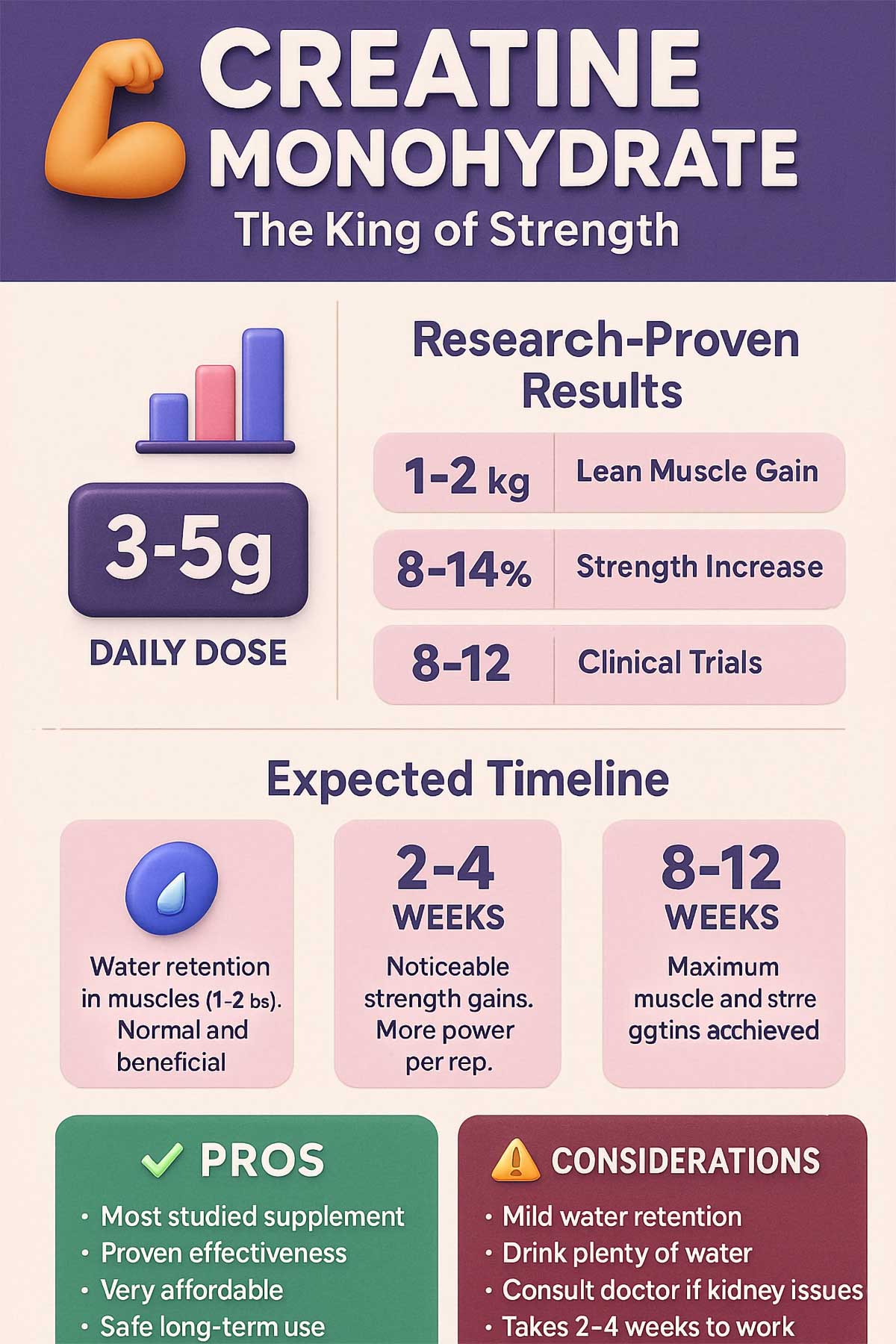
2: Protein powder (whey/casein) – the essential building blocks
You Can’t Build a House Without Bricks
Protein powder isn’t magic. It’s just food in a convenient form. But that convenience matters.
Your muscles need protein to grow. When you lift weights, you create tiny tears in muscle fibers. Protein repairs those tears. The repair process makes muscles bigger and stronger. This is called muscle protein synthesis.
Here’s the key finding: A landmark 2018 study by Morton and colleagues in the British Journal of Sports Medicine analyzed more than 40 randomized controlled trials. The conclusion was definitive. Consuming at least 1.6 grams of protein per kilogram of body weight per day leads to greater gains. People who hit this target gain 10 to 15 percent more strength. They also add more fat-free mass than those who don’t.
For a 180-pound person, that’s about 130 grams of protein daily. You can get this from whole foods. Chicken, eggs, and fish are great sources. But protein powder makes hitting your target easier.
Whey digests fast. It’s ideal after workouts. Casein digests slowly. Some people take it before bed to keep protein synthesis going overnight.
Protein Calculator: Want to know your exact needs? Multiply your body weight in pounds by 0.73. That gives you your minimum daily protein in grams. A 200-pound person needs about 146 grams daily.
Whole Foods vs. Powder: Whole foods should be your primary protein source. They contain vitamins, minerals, and fiber. But powder offers convenience. Use it for quick post-workout nutrition or when you’re short on time.
Best Types:
- Whey Isolate: Fastest absorbing, low in lactose. Great post-workout.
- Whey Concentrate: Slightly slower, more affordable. Good all-purpose option.
- Casein: Slow digesting. Take before bed to support overnight recovery.
- Plant-Based: Pea, rice, or hemp protein for those avoiding dairy. Look for complete amino acid profiles.
MYTH BUSTER: “Protein powder damages your kidneys”
TRUTH: No evidence exists in healthy individuals. A 2018 study in the Journal of Nutrition and Metabolism found that high protein intake doesn’t harm kidney function in people with healthy kidneys. If you have pre-existing kidney disease, consult a doctor.
Protein content: supplements vs. whole foods
| Source | Protein per Serving | Cost per 25g Protein |
|---|---|---|
| Whey protein (1 scoop) | 25g | $0.60-1.00 |
| Chicken breast (4 oz) | 35g | $1.50-2.00 |
| Greek yogurt (1 cup) | 20g | $1.25 |
| Eggs (4 large) | 24g | $0.80-1.20 |
| Salmon (4 oz) | 30g | $3.00-5.00 |
Natural creatine sources:
- Beef: 1-2g per pound
- Salmon: 1-2g per pound
- Herring: 3-4g per pound
- Note: You’d need to eat 2-3 pounds of meat daily to match supplement doses
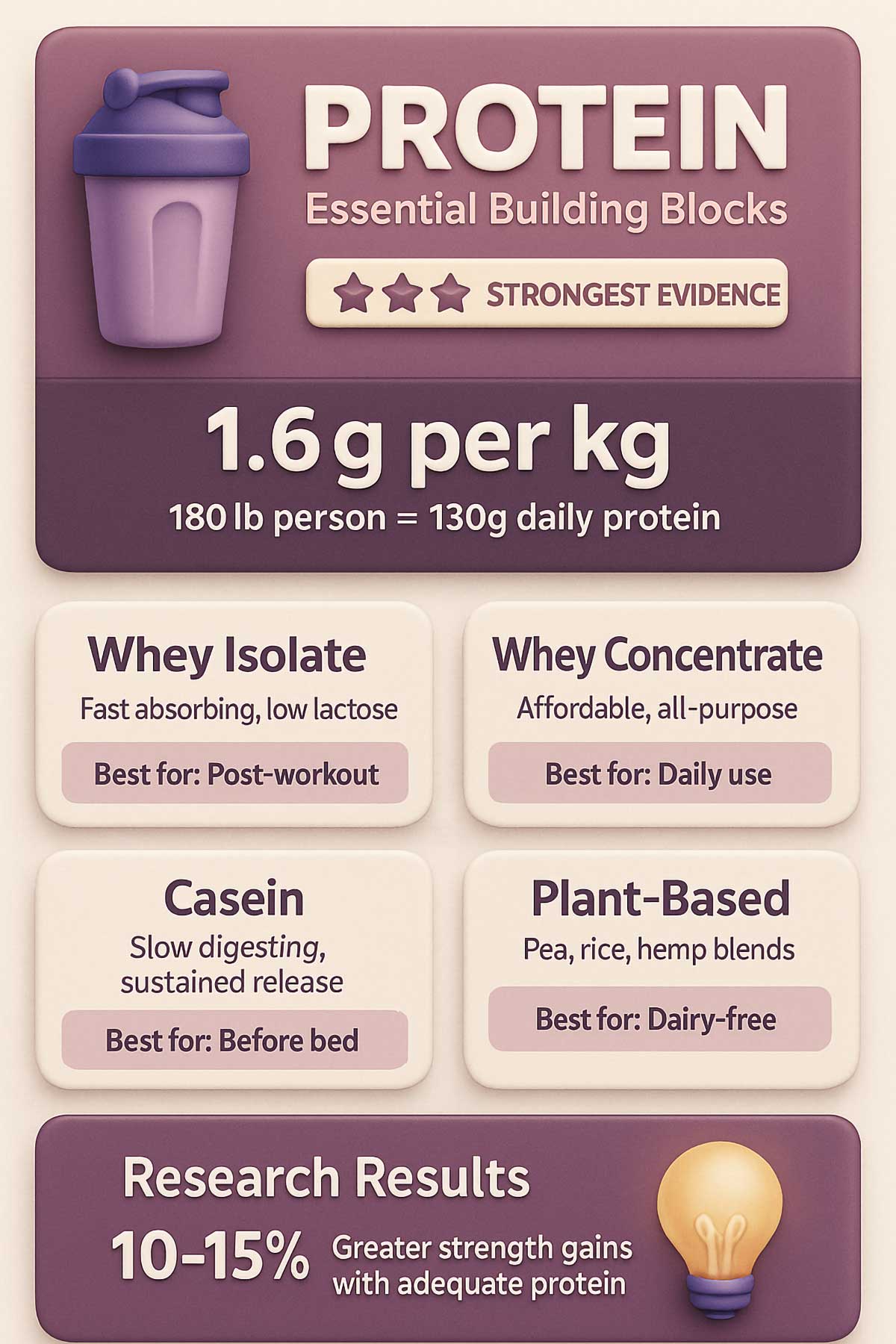
High-protein recipes that work
Post-Workout Power Smoothie
- 1 scoop whey protein (25g protein)
- 1 banana
- 1 cup spinach
- 1 tbsp almond butter
- 1 cup unsweetened almond milk
- 5g creatine monohydrate
- Ice
Total: 35g protein, 400 calories | Prep time: 3 minutes
Overnight Muscle Recovery Oats
- 1 scoop casein protein
- ½ cup rolled oats
- 1 cup Greek yogurt
- 1 tbsp chia seeds
- Berries
- Mix and refrigerate overnight
Total: 45g protein, 450 calories | Prep time: 5 minutes
High-Protein Pancakes
- 1 scoop vanilla whey protein
- 2 eggs
- 1 mashed banana
- ½ tsp baking powder
- Cook on medium heat
Total: 40g protein, 380 calories | Prep time: 10 minutes
The specialists: effective, but for the right job
Moving down the list, these supplements work. But their effects are more specialized. They boost performance and endurance. This can indirectly lead to muscle growth over time.
3: Beta-alanine – the endurance enhancer
For That Extra Rep (or Three)
Beta-alanine doesn’t build muscle directly. But it helps you do more work. More work can lead to more growth.
Here’s the science: Beta-alanine combines with another amino acid to make carnosine. Carnosine acts like a sponge in your muscles. It soaks up the acid that builds up during intense exercise. Less acid means you can push harder for longer.
A 2017 review in Nutrients analyzed multiple studies on beta-alanine supplementation. The researchers found that beta-alanine increases muscular endurance by 2 to 3 percent. That might not sound like much. But it can mean an extra few reps per set. Over weeks and months, those extra reps add up.
The catch? Beta-alanine works best for high-intensity exercise lasting 1 to 4 minutes. Think sprinting or high-rep sets. It doesn’t help much with pure strength work like heavy singles or triples.
Who It’s For: Athletes doing high-intensity training. CrossFit athletes, sprinters, and bodybuilders using high-rep schemes benefit most. Not essential for pure strength lifters.
The dose is 4 to 6 grams daily. You might feel a tingling sensation in your skin. That’s called paresthesia. It’s normal and harmless. The tingling usually fades after a few weeks of consistent use.
Beta-alanine loading schedule
| Week | Daily Dose | Expected Effect |
|---|---|---|
| 1-2 | 4-6g | Tingling sensation, minimal performance change |
| 3-4 | 4-6g | Carnosine levels rising, slight endurance boost |
| 4-6 | 4-6g | Full saturation, maximum 2-3% endurance increase |
| Ongoing | 4-6g | Maintain elevated carnosine levels |
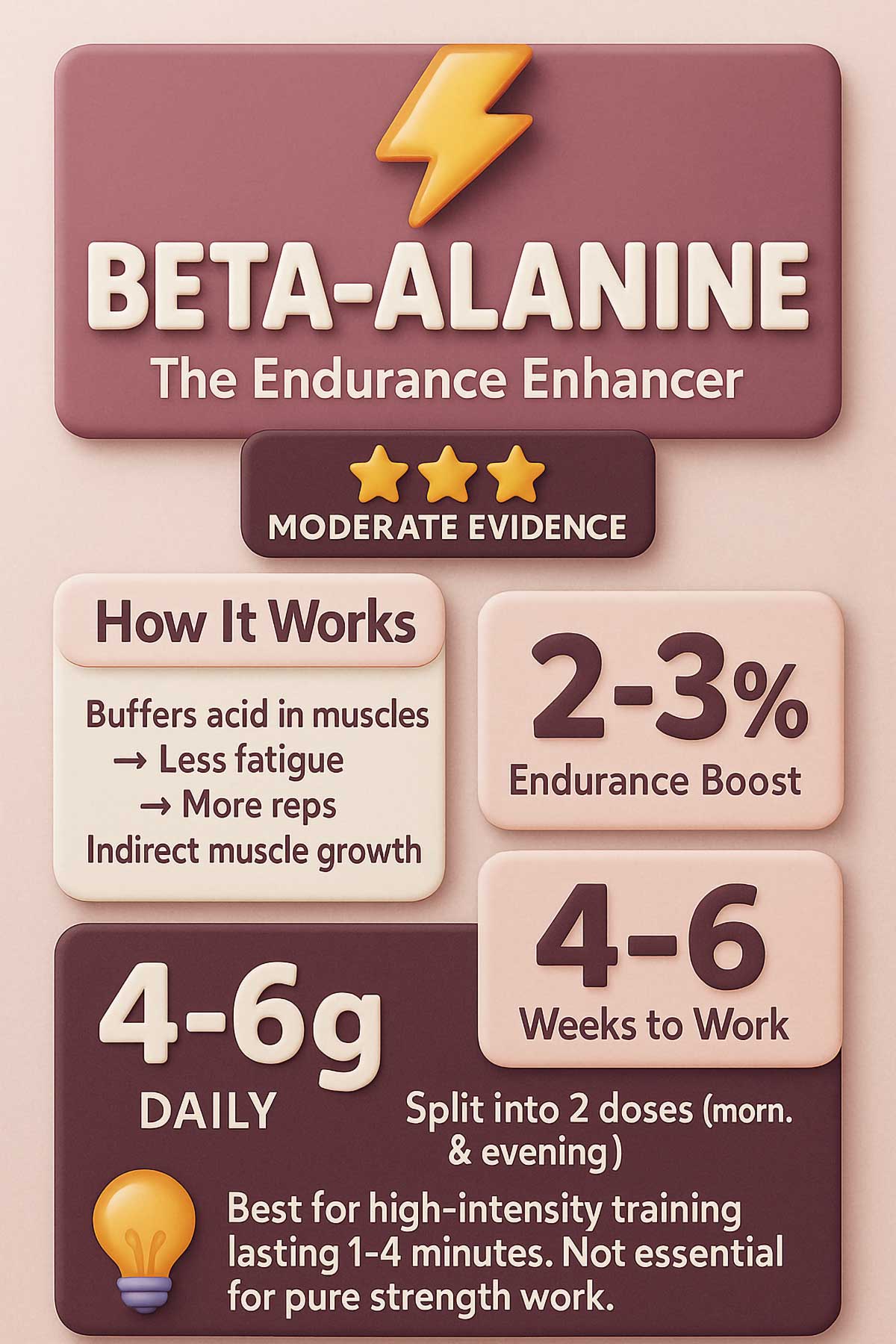
4: Omega-3 fatty acids – the unsung hero for recovery & growth (especially as you age)
More Than Just Brain Food
You’ve heard omega-3s are good for your heart and brain. But they also play a role in building muscle.
Omega-3s are fats found in fish oil. The two most important types are EPA and DHA. These fats reduce inflammation. Less inflammation means faster recovery. Faster recovery means you can train harder more often.
But there’s more. A 2015 study in the American Journal of Clinical Nutrition gave omega-3 supplements to adults over 60. The participants took 2 to 3 grams daily while doing resistance training. The omega-3 group experienced enhanced muscle protein synthesis. They gained more strength than the placebo group. The researchers concluded that omega-3s make muscles more sensitive to protein and exercise signals.
This effect is especially strong in middle-aged and older adults. If you’re younger and already eating fish regularly, omega-3 supplements might not add much. But if you’re over 40 or don’t eat fish, they’re worth considering.
The Dose: Take 2 to 3 grams of combined EPA and DHA daily. Look for a quality fish oil supplement. Check the label for EPA and DHA content, not just total fish oil. Many cheap products contain mostly filler oils.
What to Look For:
- EPA + DHA content clearly listed
- Third-party tested for mercury and contaminants
- Triglyceride form absorbs better than ethyl ester
- Keep refrigerated to prevent oxidation
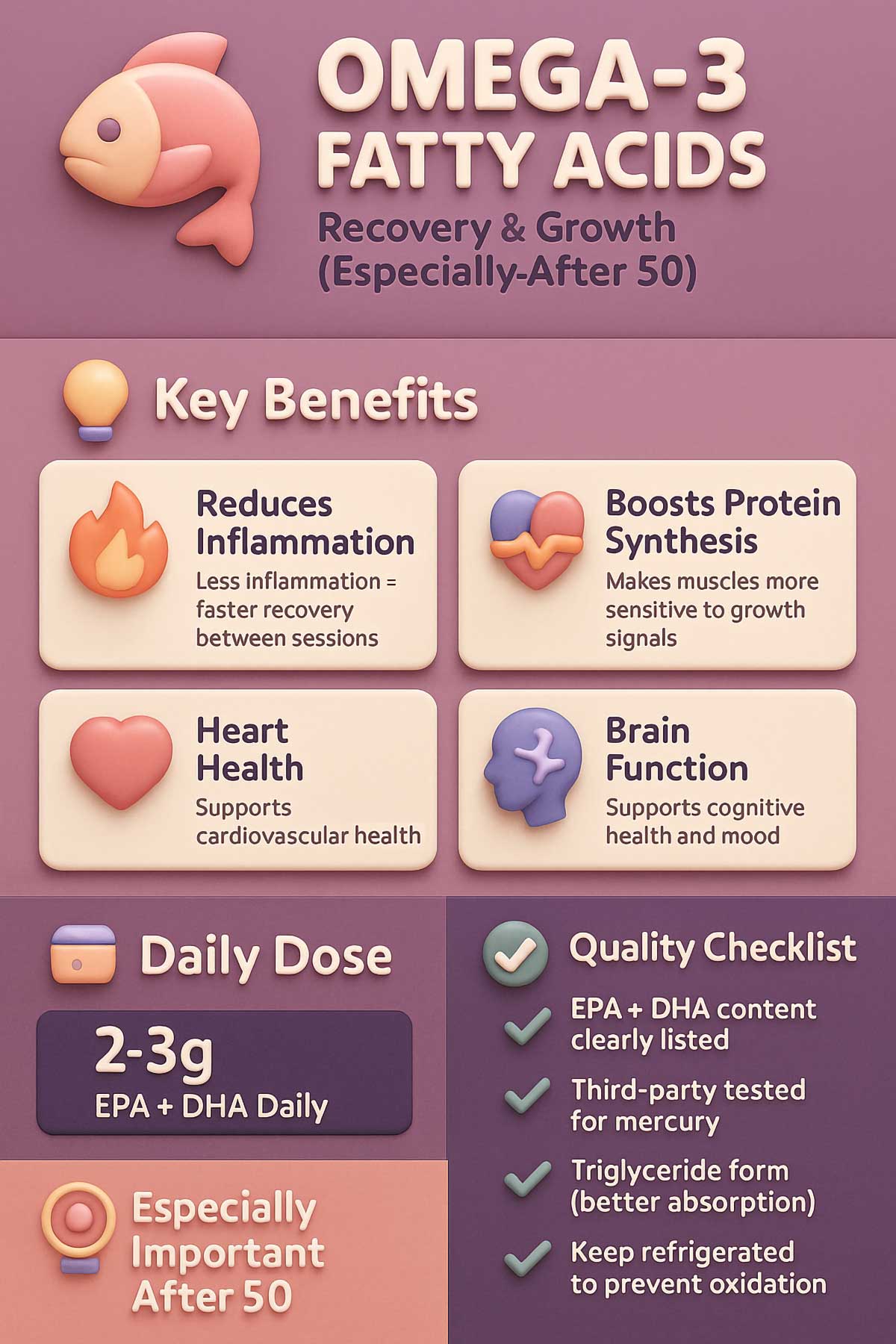
The overhyped & overpriced: proceed with caution
Here’s where the results get surprising. These supplements are popular. They’re heavily marketed. But the scientific evidence for muscle growth is either mixed, weak, or non-existent if your diet is already on point.
5: HMB (β-Hydroxy β-Methylbutyrate) – the disappointment for trained lifters
Big Promises, Small Returns
HMB is a metabolite of leucine. Leucine is an amino acid that triggers muscle growth. Companies market HMB as a way to prevent muscle breakdown and boost gains.
The problem? It barely works for people who already lift weights.
A 2021 review in Nutrients examined the full body of HMB research. The findings were clear: HMB has minimal to no effect in trained individuals. The small benefits it does provide show up mostly in untrained beginners. Older adults trying to prevent muscle loss also see some benefit.
Why the difference? If you’re already training hard, your body adapts. It gets better at using the nutrients you give it. HMB doesn’t add much to an already optimized system.
The conclusion was definitive: HMB might help preserve muscle during bed rest or in clinical settings. But for regular gym-goers? The gains are so small they’re not worth the cost.
Verdict: Save your money if you’re a seasoned gym-goer. If you’re a complete beginner or an older adult focused on preventing muscle loss during illness or inactivity, it might help slightly. But even then, protein and creatine are better investments.
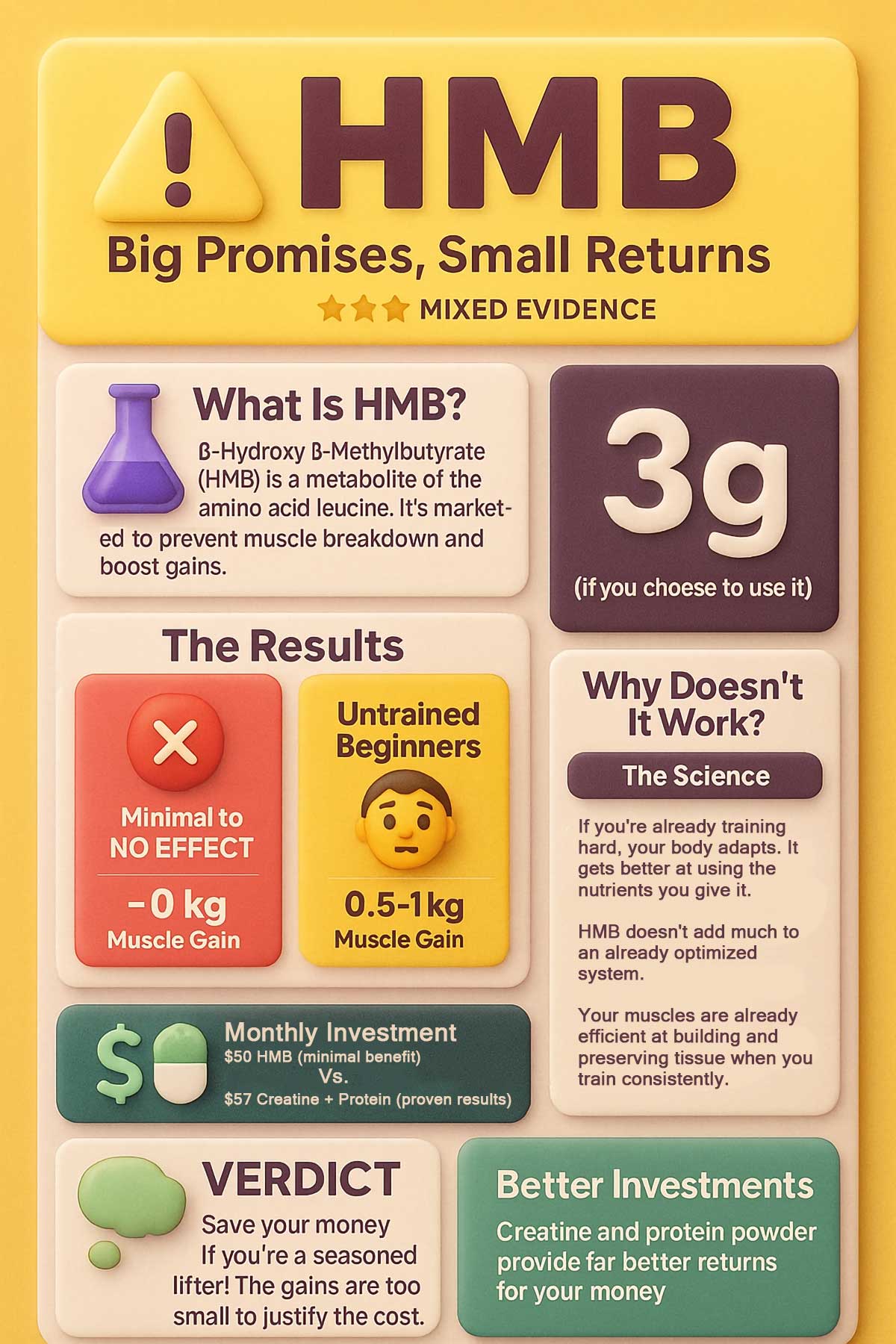
6: Citrulline malate – the ‘pump’ provider with unproven growth benefits
Feels Good, But Does It Build?
Citrulline malate is a popular pre-workout ingredient. It increases nitric oxide production. More nitric oxide means better blood flow. Better blood flow gives you that satisfying muscle “pump” during workouts.
The pump feels great. It makes your muscles look fuller. But does it translate to actual growth?
The evidence is mixed. A 2018 study in the European Journal of Applied Physiology tested citrulline supplementation in trained lifters. Some studies show citrulline reduces fatigue. You might squeeze out an extra rep or two. Other studies show no benefit at all. And when it comes to actual muscle hypertrophy, the data is inconsistent.
Part of the problem is dosing. Many pre-workout products contain small amounts of citrulline. The studies showing benefits used 6 to 8 grams. That’s more than most supplements provide.
Another issue is study design. Some research shows performance benefits. But performance doesn’t always equal growth. You need consistent overload over time.
Verdict: A decent pre-workout ingredient for performance. The pump feels good and might help you psychologically. But don’t count on it for direct muscle gains. If you want citrulline, make sure you’re getting at least 6 grams per dose.
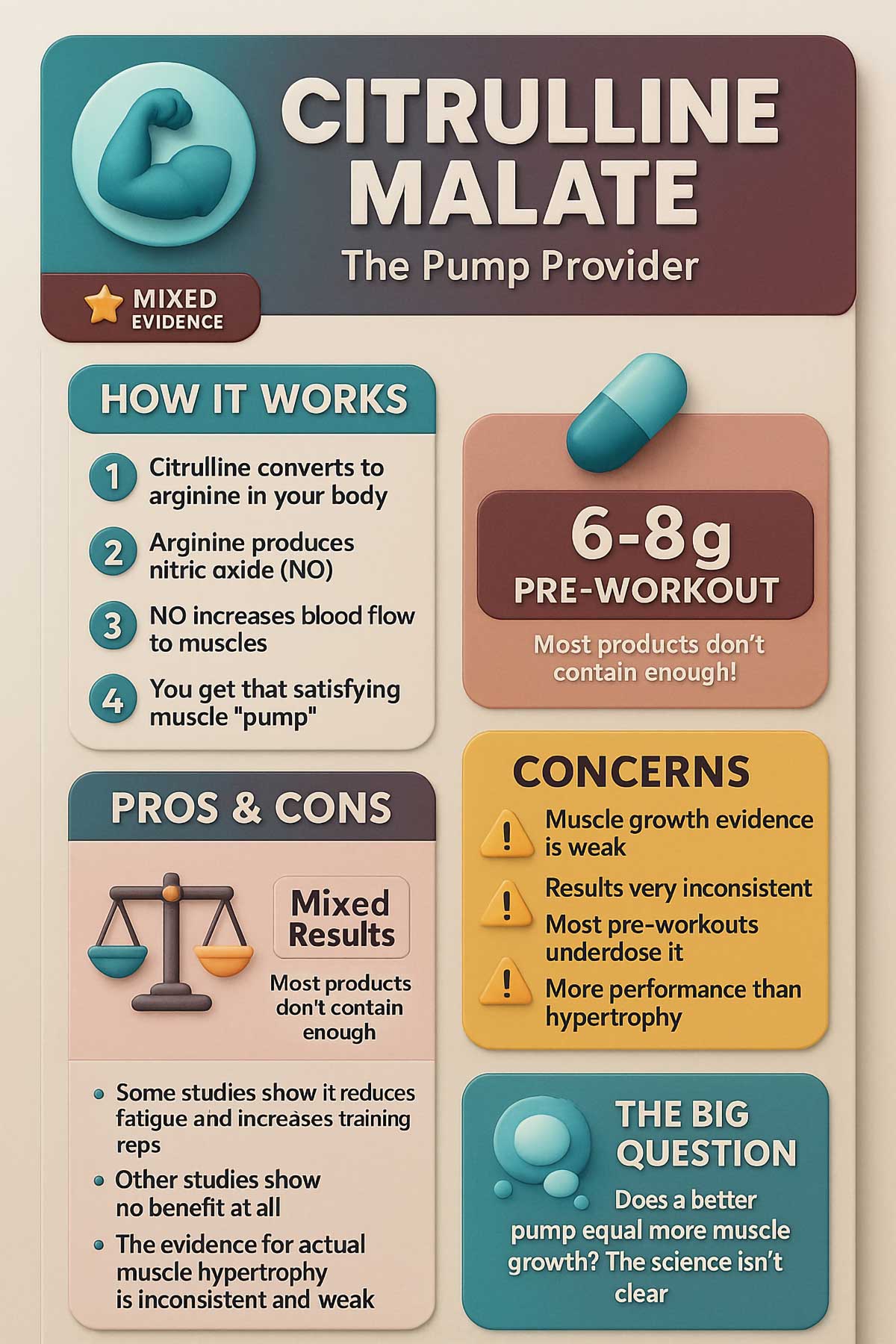
7: BCAAs (branched-chain amino acids) – the most overrated supplement?
Why Your Protein Shake Is Already Doing the Job
BCAAs are three amino acids: leucine, isoleucine, and valine. They’re called “branched-chain” because of their chemical structure. Companies market them as essential for muscle growth and recovery.
Here’s the truth: BCAAs are essential. Your body can’t make them. You need to get them from food. But you’re already getting them if you eat protein.
A 2017 study published in Frontiers in Physiology compared BCAA supplements to whey protein in resistance-trained individuals. The findings were unequivocal: BCAAs provide no additional benefit for muscle growth if you’re consuming enough complete protein. The researchers tested BCAA supplements against equal amounts of whey protein. Whey won every time.
Why? Whey contains all nine essential amino acids. BCAAs only have three. Your body needs all nine to build muscle effectively. Taking BCAAs alone is like giving your body an incomplete toolkit.
The study authors stated plainly: BCAA supplements are no better than isonitrogenous protein sources. That’s science speak for “they’re not better than regular protein.”
The supplement industry has done a masterful job marketing BCAAs. They’re everywhere. But the science doesn’t support the hype.
MYTH BUSTER: “You need protein within 30 minutes post-workout”
TRUTH: The “anabolic window” is overblown. Total daily protein matters most. Research shows the window is actually several hours, not 30 minutes. Focus on hitting your daily target.
Verdict: An expensive way to get a few amino acids that are already abundant in your protein powder. Skip them. Invest in quality whey or casein instead. Or just eat more chicken and eggs.
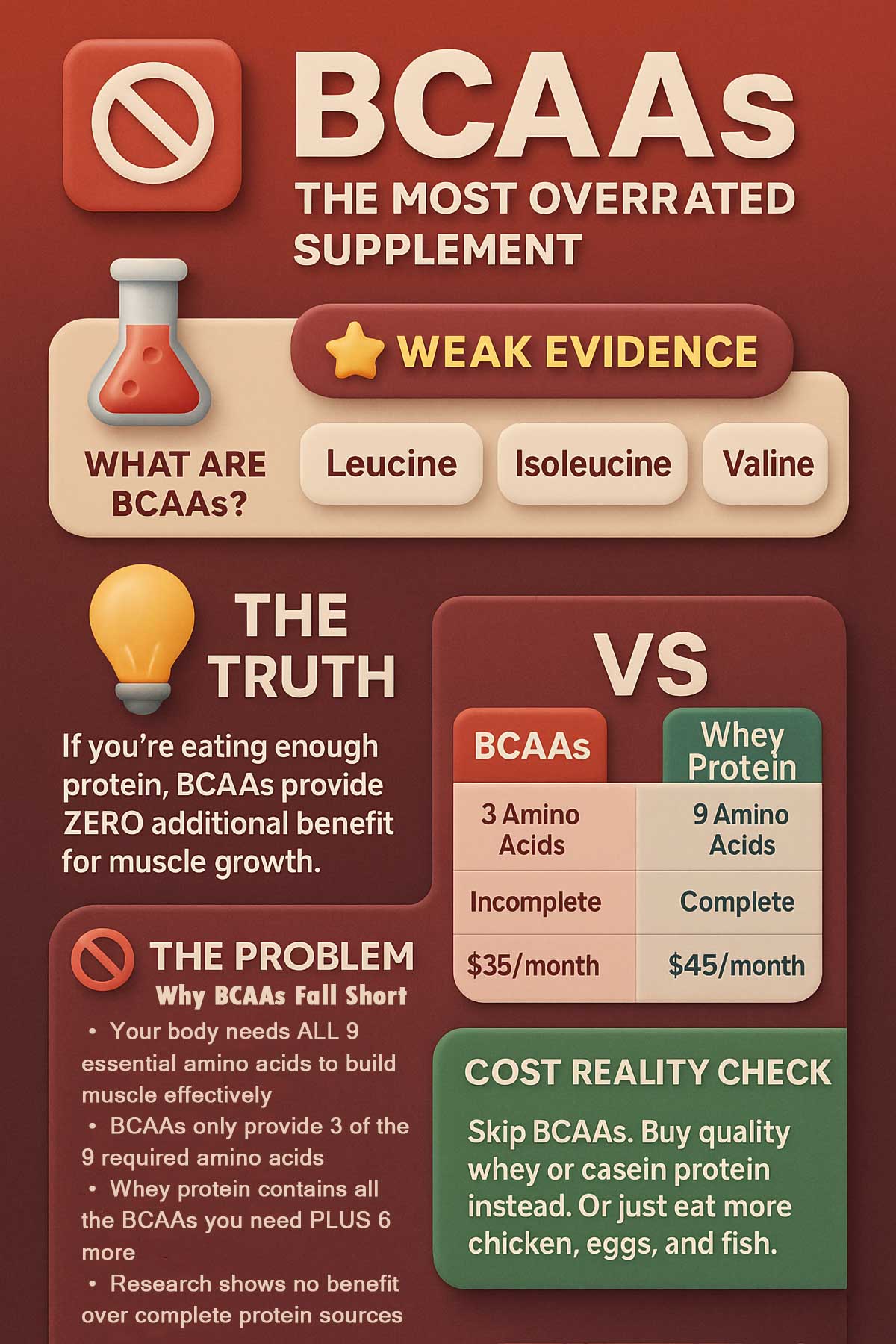
What's Your Supplement IQ?
Test your knowledge and learn the truth
Test Your Knowledge
Think you know which supplements actually work? Take this 10-question quiz to test your knowledge and learn what science really says about muscle-building supplements.
0/10
Correct Answers
Your Results
Building and keeping muscle after 50: what changes
Age changes the game. After 50, your body becomes more resistant to the muscle-building signals from protein and exercise. Scientists call this “anabolic resistance.” But you can fight back.
The science of aging muscle
A 2019 study in Nutrients examined muscle protein synthesis in older adults. The researchers found that people over 50 need more protein per meal to trigger the same growth response as younger people. They need about 40 grams per meal, compared to 20-25 grams for younger adults.
Your body also loses muscle faster with age. After 50, you can lose 1 to 2 percent of muscle mass per year if you don’t resistance train. This condition is called sarcopenia.
Priority supplements for the over-50 crowd
1. Protein Powder – Even More Critical
Older adults should aim for the higher end of protein intake. Target 1.6 to 2.0 grams per kilogram of body weight daily. A 2015 study in the Journal of the American Medical Directors Association found that higher protein intake helps prevent age-related muscle loss.
Spread your protein across the day. Aim for 30-40 grams per meal instead of loading it all at dinner.
2. Creatine – Your Anti-Aging Ally
Creatine isn’t just for young bodybuilders. A 2017 meta-analysis in Medicine & Science in Sports & Exercise studied creatine in older adults. The findings were impressive. Older adults who took creatine while resistance training gained significantly more muscle mass and strength than those who didn’t.
The benefits go beyond muscle. Creatine may support bone density and cognitive function. Both decline with age.
3. Omega-3s – Non-Negotiable After 50
Fish oil becomes more important as you age. The 2015 study mentioned earlier showed that omega-3 supplementation specifically benefits older adults. It enhances the muscle-building response to protein and exercise.
Omega-3s also reduce chronic inflammation. This “inflammaging” interferes with muscle growth and recovery.
4. Vitamin D – The Missing Link
Low vitamin D is common in older adults. A 2019 study in the Journal of Clinical Endocrinology and Metabolism found that vitamin D deficiency is linked to muscle weakness and increased fall risk.
Get your levels tested. Aim for 2,000 to 4,000 IU daily if you’re deficient. Vitamin D works with protein and exercise to maintain muscle.
Training considerations for older adults
Supplements only work if you train. But training changes after 50.
Key adjustments:
- Longer warm-ups to prepare joints and tendons
- Focus on compound movements like squats and presses
- Allow more recovery time between hard sessions
- Prioritize form over ego lifting
- Include mobility work to maintain range of motion
A 2018 study in Experimental Gerontology found that older adults can still build muscle. The rate is slower than younger people, but the potential remains. The key is consistency and proper progression.
The over-50 supplement stack
Foundation (Non-Negotiable):
- Protein powder: 1 scoop, 2-3 times daily
- Creatine: 5g daily
- Omega-3s: 3g EPA+DHA daily
- Vitamin D: 2,000-4,000 IU daily
Optional Additions:
- Beta-alanine: If doing high-intensity training
- Collagen: May support joint health (10-15g daily)
Monthly cost: $60-90
Real talk for the over-50 lifter
You won’t build muscle as fast as a 25-year-old. That’s biology. But you can absolutely get stronger and add muscle. The research proves it.
The difference is you need to be smarter. You can’t skip meals and expect to grow. You can’t train hard seven days a week and recover. You need more protein, better sleep, and strategic supplementation.
But here’s the good news: muscle you build after 50 is muscle that helps you stay independent. It protects your bones. It keeps your metabolism healthy. It lets you play with your grandkids without getting tired.
That’s worth more than any pump in the gym.
How to stack supplements for maximum results
Don’t buy everything at once. Build your supplement stack in stages based on your experience and budget.
Level 1 – the foundation (everyone should start here)
What to buy:
- Creatine monohydrate: 5g daily
- Protein powder: Enough to meet your 1.6g/kg daily target
Monthly cost: $40-75
Expected benefit: Maximum evidence-based gains. These two supplements have the strongest research backing. They work for beginners and advanced lifters alike.
Who it’s for: Anyone serious about building muscle on a budget. This is the 80/20 of supplements. You get 80% of the benefit for 20% of the cost.
Level 2 – the optimizer (serious athletes)
Add to foundation:
- Beta-alanine: 4-6g daily (split into 2 doses)
- Omega-3s: 2-3g EPA+DHA daily
Monthly cost: $75-130
Expected benefit: Enhanced performance during high-intensity training. Better recovery between sessions. Particularly valuable for athletes over 40.
Who it’s for: People training 4-6 days per week with intensity. Competitive athletes. Anyone doing high-volume training who can afford the extra expense.
Level 3 – the experimental (deep pockets only)
Add to Level 2:
- Citrulline malate: 6-8g pre-workout
- Vitamin D: If deficient (get tested first)
Monthly cost: $90-155
Expected benefit: Marginal gains, mostly psychological. Better pumps and potentially improved performance. But the cost-benefit ratio drops significantly.
Who it’s for: People who have maxed out training and nutrition. Competitors looking for every edge. Those with disposable income who enjoy supplementation.
When to take what: a daily timeline
Morning (with breakfast):
- Omega-3s: 1-2 capsules
- Vitamin D: If supplementing
- Creatine: 5g (or save for post-workout)
Pre-Workout (30-60 min before):
- Beta-alanine: 2-3g
- Citrulline malate: 6-8g (if using)
Post-Workout:
- Whey protein: 1 scoop (25-30g)
- Creatine: 5g (if not taken in morning)
Evening (with dinner):
- Omega-3s: 1-2 capsules
- Beta-alanine: 2-3g
Before Bed:
- Casein protein: 1 scoop (optional, if not meeting daily protein target)
Anytime:
- Creatine: Timing doesn’t matter for creatine. Just take it daily. Some research suggests post-workout might be slightly better, but consistency matters most.
Is it worth it? Cost-benefit analysis
Let’s talk money. Supplements aren’t cheap. Here’s what you’re actually paying for.
Cost per kilogram of muscle gained
| Supplement | Monthly Cost | Expected Gain (12 weeks) | Cost per kg Gained |
|---|---|---|---|
| Creatine | $12 | 1.5 kg | $48 |
| Protein powder | $45 | 2 kg (with training) | $270 |
| Beta-alanine | $25 | Indirect (performance) | N/A |
| Omega-3s | $20 | Indirect (recovery) | N/A |
| HMB (trained lifters) | $50 | ~0 kg | Infinite |
| BCAAs | $35 | 0 kg | Infinite |
The reality check
These numbers assume you’re training hard and eating right. Supplements don’t work without the fundamentals.
A gym membership costs $30-60 per month. Quality food costs $200-400 per month. If you’re not investing in those first, don’t buy supplements.
The priority order:
- Gym membership or home equipment: $30-60/month
- Quality protein-rich foods: $200-400/month
- Adequate sleep: Free (but priceless)
- Creatine and protein powder: $40-75/month
- Everything else: Only if budget allows
Budget strategies
If you have $20 per month:
Buy creatine monohydrate. Get protein from whole foods. Track your intake to ensure you hit 1.6g/kg daily.
If you have $50 per month:
Buy creatine and a basic whey protein. This covers the essentials.
If you have $100+ per month:
Add beta-alanine and omega-3s. Consider buying in bulk for better prices.
Money-saving tips:
- Buy unflavored protein (cheaper and more versatile)
- Purchase creatine in bulk (5kg bags last months)
- Skip brand names (generic creatine monohydrate is identical)
- Avoid proprietary blends (you’re paying for marketing)
- Buy omega-3s from wholesale retailers
Your supplement strategy by experience level
Your supplement needs change as you progress. Here’s how to adjust your strategy.
Complete beginner (0-6 months training)
Priority 1: Learn proper form
Priority 2: Establish consistent training (3-4 days per week)
Priority 3: Get protein from food (1.6g/kg daily)
Supplements to consider:
- Protein powder: Only for convenience if struggling to eat enough
- Skip: Everything else for now
Why wait? Your body responds to almost any training stimulus when you start. You’ll make rapid gains without supplements. Focus on building habits. Add supplements once your progress slows.
Monthly cost: $0-30
Intermediate (6 months – 2 years)
Foundation established: You train consistently and eat well
Add to your routine:
- Creatine: 5g daily (this should be your first supplement purchase)
- Protein powder: As needed to hit daily targets
Consider:
- Beta-alanine: If doing high-intensity or high-volume training
Skip:
- HMB, BCAAs, most pre-workouts
Why these choices? You’ve built a base. Now you’re working on progressive overload. Creatine directly supports strength gains. Protein ensures recovery. Beta-alanine helps if you’re pushing training volume.
Monthly cost: $40-80
Advanced (2+ years)
Training is dialed in: You understand periodization and recovery
Foundation (non-negotiable):
- Creatine: 5g daily
- Protein: 1.6-2.0g/kg daily (powder as needed)
Fine-tuning additions:
- Beta-alanine: For specific training blocks
- Omega-3s: For recovery and health
- Vitamin D: If deficient
Experiment with:
- Citrulline: If budget allows and you enjoy the pump
- Different protein sources: Try casein, blends, or plant-based
Reality check: At this level, gains come from training and nutrition optimization, not supplements. Focus on periodization, deload weeks, and addressing weak points.
Monthly cost: $60-120
Quality and safety: what to look for
Not all supplements are created equal. Here’s how to avoid garbage products.
Third-party testing: what to look for
These certifications test for banned substances and verify label accuracy:
NSF Certified for Sport:
- Tests for banned substances
- Verifies label claims
- Trusted by professional athletes
Informed-Choice:
- Tests every batch
- Common in UK and European products
- Reliable certification
USP Verified:
- Tests for purity and potency
- Verifies manufacturing practices
- Independent lab testing
ConsumerLab:
- Independent testing organization
- Publishes detailed reviews
- Subscription required for full access
Why this matters: A 2018 study tested 134 supplements. Researchers found that 12% contained banned substances not listed on the label. Another 40% had significantly less active ingredient than claimed.
If you’re a tested athlete, third-party certification is non-negotiable. For everyone else, it’s still smart buying.
Red flags: what to avoid
Proprietary blends:
Companies hide ingredient doses behind “proprietary blends.” You can’t tell if you’re getting effective doses. Avoid products that don’t list exact amounts.
Outrageous claims:
“Build 20 pounds of muscle in 4 weeks!” is a lie. If it sounds too good to be true, it is.
Celebrity endorsements without science:
Your favorite athlete is paid to promote that product. Look for research, not testimonials.
Extremely cheap prices:
Quality costs money. If creatine costs $5 for a year’s supply, question the quality and purity.
Kitchen sink formulas:
Pre-workouts with 30+ ingredients are wasteful. You need a few key compounds in effective doses, not trace amounts of everything.
Suspicious websites:
Buy from reputable retailers. Amazon has counterfeit problems. Buy direct from manufacturers or trusted supplement stores.
How to read a supplement label
Check these elements:
1. Serving size:
Is the advertised dose realistic? Some products require 6 capsules per serving to hit effective doses.
2. Active ingredients:
Are they listed with exact amounts? Can you verify doses match research?
3. Other ingredients:
Minimal is better. Watch for allergens, artificial sweeteners, or unnecessary fillers.
4. Manufacturer information:
Is there a phone number and address? Can you contact them with questions?
5. Lot number and expiration date:
These allow batch tracking if problems arise.
The smart-growth blueprint: your action plan
Let’s recap everything into a simple action plan.
The winners: start here
Creatine and protein powder. These are non-negotiable if you’re serious about gains. They’re backed by decades of research. They work for almost everyone. They’re safe and affordable.
Why they win:
- Strongest research support (hundreds of studies)
- Clear mechanisms of action
- Consistent results across populations
- Low cost per benefit gained
- Excellent safety profiles
The specialists: add these next
Beta-alanine and omega-3s. These work, but for specific situations. Beta-alanine helps with endurance and training volume. Omega-3s are especially useful for older lifters and recovery.
When to add them:
- You’ve been using creatine and protein for 3+ months
- You’re training hard 4+ days per week
- You have room in your budget
- You’re over 40 (omega-3s become more important)
The overhyped: skip these
HMB, citrulline malate, and BCAAs. These are heavily marketed but poorly supported by science. They might help in very specific situations. But for most people, they’re a waste of money.
Why they fail:
- Weak or inconsistent research
- Benefits only in untrained or specific populations
- High cost relative to benefit
- Redundant if diet is adequate
Your foundation first
Before you buy any supplements, establish these fundamentals:
1. Training program:
- Progressive overload (increasing weight or reps over time)
- 3-5 days per week of resistance training
- Focus on compound movements
- Adequate rest between hard sessions
2. Nutrition:
- 1.6-2.0g protein per kg body weight
- Appropriate calories (surplus for muscle, deficit for fat loss)
- Mostly whole foods
- Consistent meal timing
3. Recovery:
- 7-9 hours of sleep nightly
- Stress management
- Rest days built into programming
- Adequate hydration (half your body weight in ounces daily)
4. Consistency:
- Show up even when motivation is low
- Track your workouts and nutrition
- Make small adjustments based on progress
- Think in months and years, not days and weeks
Once you have those basics locked in, add the supplements. They’ll enhance what you’re already doing. But they won’t fix a broken foundation.
The supplement purchase priority
If you can only afford one supplement:
Buy creatine monohydrate. It gives you the most benefit per dollar spent.
If you can afford two:
Add protein powder. Use it to hit your daily protein target consistently.
If you have more budget:
Consider beta-alanine if you do high-intensity training. Add omega-3s if you’re over 40 or don’t eat fish.
Everything else:
Optional. The return on investment drops significantly after the first two supplements.
Expected timeline and results
Weeks 1-4:
- Creatine loading complete
- Slight weight gain (1-2 pounds water)
- Small strength increases (5-10%)
- Better recovery if protein intake is adequate
Weeks 4-8:
- Continued strength gains
- Visible muscle changes if training and nutrition are dialed in
- Beta-alanine saturation complete (if using)
- Adaptation to training stimulus
Weeks 8-12:
- Significant strength increases (10-15% over baseline)
- Measurable muscle gain (1-3 kg if training is intense)
- Improved work capacity
- Better recovery between sessions
Beyond 12 weeks:
- Continued gains at slower rate
- Maintenance of strength and muscle
- Long-term health benefits from omega-3s
- Sustained performance improvements
These timelines assume consistent training and adequate nutrition. Results vary based on genetics, training age, and effort.
Your evidence-based supplement checklist
✅ Buy these (the foundation)
✅ Consider these (if budget allows)
❌ Skip these (waste of money)
Monthly investment totals
- Essential only: $40-75
- Essential + specialists: $75-130
- Everything useful: $90-155
Remember: Supplements should be the cherry on top. The real work happens in the gym and kitchen. Focus on training hard, eating well, and sleeping enough. Add these supplements to maximize what you’re already doing right.
FAQs
Can I take all these supplements together?
Yes. Creatine, protein, beta-alanine, and omega-3s can be taken together safely. No negative interactions exist. Start with creatine and protein first. Add others gradually.
Do supplements work if I don’t train hard?
No. Supplements enhance training results. Without proper exercise, they’re worthless. You can’t supplement your way out of a bad training program.
How long before I see results?
Creatine: 2-4 weeks for strength gains. You might notice water weight in the first week.
Protein: 6-8 weeks for visible muscle gains. But you’ll recover better within days.
Beta-alanine: 4-6 weeks for full saturation. Endurance benefits build gradually.
Omega-3s: 8-12 weeks for measurable changes in inflammation and recovery.
Are supplements safe for women?
Absolutely. Women benefit equally from creatine and protein. The research includes both sexes. Creatine doesn’t cause masculine features. Protein doesn’t make you “bulky.” These are myths.
Women may need the same absolute doses as men for creatine (5g daily). But protein needs are based on body weight, so a 130-pound woman needs less than a 200-pound man.
Will creatine make me bloated?
You might retain 1-2 pounds of water. This is intramuscular water, not bloat. It’s actually beneficial for growth signals. The water stays inside muscle cells, making them fuller. It’s not subcutaneous water that makes you look puffy.
If you experience stomach discomfort, try taking creatine with food or splitting the dose into smaller amounts throughout the day.
Do I need supplements if I’m vegetarian or vegan?
Creatine is especially beneficial for vegetarians and vegans. Dietary sources come from meat and fish. A 2003 study in the Journal of the International Society of Sports Nutrition found that vegetarians have lower baseline creatine levels. They experience even greater strength gains from supplementation than meat-eaters.
Protein powder also helps. Plant-based options include pea, rice, and hemp protein. Look for blends that provide complete amino acid profiles. Single-source plant proteins are often low in certain amino acids.
Plant-based protein tips:
– Combine sources (rice + pea) for complete amino acid profile
– Look for “complete protein” on labels
– Consider slightly higher daily intake (1.8-2.0g/kg)
– Add lysine-rich foods like quinoa and legumes
Can teenagers take these supplements?
Protein powder is safe for teenagers. It’s just food. If a teen can eat chicken, they can drink protein powder.
Creatine is generally considered safe for teens aged 13 and older who train seriously. A 2009 position statement by the International Society of Sports Nutrition supports creatine use in young athletes under proper supervision.
That said, teenagers should focus on food first. Their bodies are growing rapidly. Whole foods provide nutrients beyond just protein. Use supplements only to fill gaps, not replace meals.
Parents should consult a doctor if concerned. Start with conservative doses.
What about pre-workout formulas?
Most pre-workouts contain caffeine plus small doses of the supplements discussed here. You’re often better buying individual ingredients.
Problems with pre-workouts:
– Underdosed active ingredients (50mg of beta-alanine when you need 4,000mg)
– Excessive caffeine (300mg+ per serving)
– Proprietary blends hiding actual doses
– Expensive compared to buying separate ingredients
When pre-workouts make sense:
– You want convenience and caffeine in one product
– You’ve found one with transparent labeling
– The doses of active ingredients match research
– You understand you’re paying a premium for mixing
If you buy pre-workout, look for products with at least 3-4g beta-alanine and 6g citrulline per serving. Most don’t come close.
Will supplements help me lose fat?
Not directly. Supplements discussed here build muscle. More muscle increases your metabolism slightly. But the effect is small.
Protein powder can help with fat loss indirectly. Protein is more satiating than carbs or fat. A high-protein diet helps preserve muscle during a calorie deficit.
Creatine might make you retain water. This can temporarily mask fat loss on the scale. But it’s not actual fat gain. Body composition matters more than scale weight.
For fat loss, prioritize:
1. Calorie deficit (eat less than you burn)
2. High protein intake (preserve muscle)
3. Resistance training (maintain strength)
4. Adequate sleep (control hunger hormones)
5. Consistency (months, not weeks)
Supplements are tools. They don’t replace the fundamentals.
How do I know if a supplement is working?
Track objective measures:
For creatine:
– Weight on the bar (are your lifts going up?)
– Body weight (should increase 1-2 pounds from water)
– Rep count (can you do more reps at same weight?)
For protein:
– Body composition (gaining muscle, not just fat?)
– Recovery (less soreness between sessions?)
– Performance (maintaining strength in a deficit?)
For beta-alanine:
– Training volume (can you do more total work?)
– Time to failure (lasting longer in high-rep sets?)
– Perceived exertion (same work feels easier?)
Take progress photos every 4 weeks. Measure body parts monthly. Track your workouts religiously. These objective measures beat feelings.
If you don’t track, you can’t know what works.
Can I take creatine if I’m trying to look lean?
Yes. The water retention from creatine is intramuscular. It makes muscles look fuller, not bloated. Many physique competitors take creatine year-round.
If you’re preparing for a photo shoot or competition, you might drop creatine a week before. But for everyday leanness, keep taking it. The strength benefits help you maintain muscle while dieting.
What if I miss a day of supplements?
No big deal. Creatine builds up in your muscles over time. Missing one day doesn’t erase weeks of loading. Just resume your normal dose the next day.
Protein is about total daily intake. If you miss your shake but eat extra chicken, you’re fine. Focus on hitting your daily target, not rigid timing.
Consistency beats perfection. Take your supplements most days and you’ll get results.
Are there any supplements that actually burn fat?
Most “fat burners” are caffeine plus unproven ingredients. Caffeine does increase metabolism slightly. You burn maybe an extra 50-100 calories per day. That’s one apple.
The research on fat burners is weak. A 2012 review in Obesity Reviews analyzed popular fat-burning ingredients. Most showed minimal or no effect. The few that worked (like ephedrine) are banned due to safety concerns.
Your money is better spent on quality food and a gym membership. Fat loss comes from sustained calorie deficit, not pills.
Should I cycle supplements?
Creatine: No need to cycle. Your body doesn’t develop tolerance. Research shows continuous use for up to 5 years is safe.
Beta-alanine: No need to cycle. Carnosine levels remain elevated with consistent use.
Protein: It’s food. You don’t cycle food.
Omega-3s: No cycling needed. Benefits are cumulative.
The cycling myth comes from steroid use, where cycling is necessary. Supplements discussed here don’t work like steroids. They support normal biological processes.
What about supplement timing around workouts?
Pre-workout (30-60 min before):
– Caffeine: 3-6mg per kg body weight (if using)
– Beta-alanine: 2-3g
– Citrulline: 6-8g
During workout:
– Water: Most important
– BCAAs: Not needed if you ate protein before training
Post-workout (within 2-3 hours):
– Protein: 25-40g
– Creatine: 5g (or anytime during the day)
– Carbs: If eating in a surplus
Truth about timing: Research shows the “anabolic window” is wider than previously thought. A 2013 study in the Journal of the International Society of Sports Nutrition found that total daily protein matters more than immediate post-workout intake.
Focus on daily totals first. Dial in timing second.


